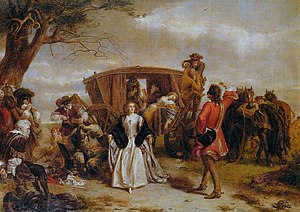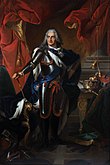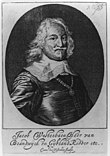1670
Appearance
This articleneeds additional citations forverification.(March 2020) |
| Millennium: | 2nd millennium |
|---|---|
| Centuries: | |
| Decades: | |
| Years: |

| 1670 by topic |
|---|
| Arts and science |
| Leaders |
| Birth and death categories |
| Births–Deaths |
| Establishments and disestablishments categories |
| Establishments–Disestablishments |
| Works category |
1670(MDCLXX) was acommon year starting on Wednesdayof theGregorian calendarand acommon year starting on Saturdayof theJulian calendar,the 1670th year of theCommon Era(CE) andAnno Domini(AD) designations, the 670th year of the2nd millennium,the 70th year of the17th century,and the 1st year of the1670sdecade. As of the start of 1670, the Gregorian calendar was 10 days ahead of the Julian calendar, which remained in localized use until 1923.
Events
[edit]January–March
[edit]- January 17–Raphael Levy,a Jewish resident of the city ofMetzinFrance,is burned at the stake after being accused of the September 25 abduction and ritual murder of a child who had disappeared from the village ofGlatigny.The prosecutor applies to KingLouis XIVfor an order expelling all 95 Jewish families from Metz, but the king refuses.
- January 27– TheMuslimemperorAurangzebof theMughal EmpireinIndiaissues an order for the destruction of allHindutemples and schools in the empire, including theKeshvadeva TempleinMathura.
- February 4– TheBattle of Sinhagadtakes place inIndia(in the modern-dayMaharashtrastate) as theMaratha Empirearmy, led byTanaji Malusare,leads an assault on the Kondhana Fortress that had been captured by theMughal Empire.Tanaji, called "The Lion" by his followers, captures the fortress by guiding the successful scaling of the walls of the fortress with ladders created from rope, but is killed in the battle. The Maratha emperorShivajiorders the fortress namedSinhagad,theMarathi languagewords for "Lion's Fort".
- February 9–Christian Vbecomes theking of Denmark-Norwayupon the death of his father,Frederick III.
- February 27– The royal wedding in Poland, betweenKing Michal Wisniowiecki(who is also theGrand Duke of Lithuania) andEleonore of Austria(daughter of the lateFerdinand III,Holy Roman Emperor), with ceremonies taking place at the Denhoff Palace inKruszyna.
- March 7–Oliver Plunkett,the Roman CatholicArchbishop of Armaghsince 1669, is allowed to return toIrelandfor the first time in more than 22 years, after a new policy of tolerance of Catholicism is enacted in England. Plunkett had departed for Rome in 1647 during theCromwellian conquest of Ireland.Later executed in 1681 on charges of plotting an invasion of Ireland, Plunkett is canonized as a saint of the Roman Catholic Church in 1975.
- March 15– The first English settlers arrive at the modern-day U.S. state ofSouth Carolina,at this time the Province of Clarendon carved out of theProvince of Carolina,and construct a settlement at Albemarle Point on theAshley River.[1]
- March 18–Petar Zrinski,theViceroy of Croatiawithin theHoly Roman Empire,issues a proclamation urging Croatians to rebel against the Habsburg rulers.[2]The uprising fails and Zrinski and his brother-in-law, Krsto Frankopan, are quickly arrested. Both are beheaded in Vienna on April 30, 1671.
- March 31– The British warshipHMSSapphireis wrecked beyond repair when her captain, John Pearce, orders the ship to be run aground at Sicily while fleeing what he believes to be four Algerian pirate ships, rather than attempting to fight. The ships turn out to have been friendly, and Pearce and his lieutenant, Andrew Logan, are court-martialed for their cowardice and executed on September 17.[3]
April–June
[edit]- April 18– King Christian V of Denmark firesChristoffer Gabel,who had been the corrupt chief adviser to King Frederick III, and replaces him withPeder Griffenfeld.
- April 29– After more than four months, thepapal conclaveto elect a successor to the latePope Clement IXselects Cardinal Emilio Albieri with 56 of the 59 votes. Altieri, 79 years old at the time, remains the oldest person ever to be elected pope.[4]He announces that he will take the name ofPope Clement Xin honor of Clement IX, who had made him a cardinal. He serves for six years until his death in 1676 shortly after his 86th birthday.[5]
- May 2– TheHudson's Bay Companyis granted a royal charter in England with the jurisdiction to control administration and commerce in "Rupert's Land",governed for the crown byRupert, Duke of Cumberland,the cousin of King Charles II. The land is a 1.5 million square mile area of what is nowCanadaaroundHudson Bay.The area controlled covers all of the modern province ofManitoba,most ofSaskatchewan,and significant portions ofAlbertaandNunavut,as well as parts of what are nowOntarioandQuebec,and parts of the U.S. states ofMinnesota,North DakotaandMontana.
- May 23–Cosimo III de' Medicibecomes theGrand Duke of Tuscany,at the time an independent nation in Italy, upon the death of his fatherFerdinando de' Medici.
- June 1– AtDover,England,Charles II of EnglandandLouis XIV of Francesign theSecret Treaty of Dover,ending hostilities between their kingdoms. Louis will give Charles 200,000 pounds annually. In return Charles will relax the laws against Catholics, gradually re-Catholicize England, support French policy against theDutch Republic(leading England into theThird Anglo-Dutch War), and convert to Catholicism himself. The treaty is ratified three days later. The terms will not become public until the early 19th century.[6]Louis is represented in the negotiations by Charles' sisterPrincess Henrietta, Duchess of Orléans,who dies suddenly soon after returning to France.
- June 9– Taking advantage of amonsoon,theMarathaEmpire'sShivajiorders an attack on areas that had been turned over to the Mughal Empire and its emperorAurangazebin 1665. Within 15 days, the cities of Pune, Baramati, Supi and Indapur, along with theRohida fort,are recaptured by the Maratha Army.
- June 10– King Louis XIV of France issues an ordinance prohibiting the French colonies in the Americas from trading with any other nation except France.[7]
- June 15– The first stone ofFort Ricasoliis laid down in Malta.[8]
July–September
[edit]- July 11– Representatives ofEngland(led byKing Charles II) andDenmark(led byKing Christian V) sign a treaty of alliance and commerce, theTreaty of Copenhagen.
- July 18(July 8, O.S.) – TheTreaty of Madrid,also known as the Godolphin Treaty, is signed betweenEnglandandSpainto formally end hostilities left over from theAnglo-Spanish War,in the Caribbean, that ended ten years earlier. For the first time, Spain acknowledges that it is not entitled to all territory in the Americas west of Brazil, as provided by the1493line of demarcation decreed byPope Alexander VI,and by the1494Treaty of Tordesillasbetween Spain and Portugal. Spain acknowledges thatJamaicaand theCayman Islandsare English possessions.
- August 17– A joint fleet of warships from England (commanded by Commodore Richard Beach on HMSHampshire) and from the Dutch Republic (led by Admiral Willem Joseph van Ghent onSpiegel) rescue 250 Christian slaves and then sink sixAlgerianpirate ships in a battle in the Mediterranean Sea off of the coast ofMoroccoatCape Spartel.[9]
- August 26– The Parliament of France enacts a uniform criminal code for the nation with the passage of theCriminal Ordinance of 1670,which takes effect on January 1. The code remains in force until October 9, 1789, when it is abrogated during theFrench Revolution.
- mid-August– Three Spanish frigates from Spanish Florida, sailing from St. Augustine and under the command of Juan Menendez Marques, arrive atCharlestonharbor, preparing to attack the English settlement in South Carolina. The English settlers have been warned in advance by Indians who had found out about the invasion. Because of a storm, and the English preparations for a siege, Captain Menendez abandons the colony without attempting an attack.[10]
- September 5–William PennandWilliam Meadare found not guilty of violating theConventicles Act 1670,after a five day jury trial in London. The two had been arrested on August 14 in front of a meeting houseGracechurch Streetafter preaching a Quaker sermon outside following a ban on preaching indoors. The defiance by the jury leads to the landmark English decision inBushel's Case.
October–December
[edit]- October 3– In India,ChhatrapatiShivajimaharaj, the ruler of theMaratha Empire,leads an attack on the British settlement atSuratnearBombay.British GovernorGerald Aungiersecures the British fortress at Surat and saves the lives and property of British citizens.
- October 14–Le Bourgeois gentilhomme,a five-act comedy and ballet authored byMolière,is given its first performance, presented before KingLouis XIVat theChâteau de Chambord.Public performances begin on November 23 at theThéâtre du Palais-RoyalinParis.
- October 18– TheBattle of Kitombotakes place in southwest Africa inAngola,when colonial soldiers of theArmy of Portugalinvade Soyo, an independentBaKongokingdom, with the intent of anne xing it to Portuguese West Africa.[11]The 400 Portuguese troops, led by João Soares de Almeida, encounter a stiff resistance. Soyo's Estevao da Silva, whose army has the benefit of weapons supplied by the Dutch Republic, is joined in battle by troops from the neighboringKingdom of Ngoyoon the other side of theCongo River.General Soares de Almeida is killed, and most of his troops die or are captured; Soyo's General da Silva is killed in the process of winning the battle. Because of the defeat, Portugal makes no further attempt to conquer Soyo or Ngoyo.
- November 24–Louis XIV of Franceinaugurates the construction ofLes Invalides,a veterans' hospital inParis.
- December 15–Henry Morgan,aWelshprivateerin English service, recapturesSanta Catalina Island, Colombia.
- December 27– Henry Morgan capturesFort San Lorenzo,onPanama's Caribbean coast.
- December 31– The expedition ofJohn NarboroughleavesCorral Bayhaving surveyed the coast and lost four hostages to the Spanish.[12]
Date unknown
[edit]- Stenka Razinbegins the rebellion ofCossacksin Russia.
- Niani, capital of theMali Empire,is sacked by theBambara peopleof the emerging Segou Empire.
- The first French settlers arrive on thePetite Côteof modern-daySenegal.
Births
[edit]
- January 24–William Congreve,English playwright (d.1729)[13]
- February 25–Maria Margarethe Kirch,German astronomer (d.1720)
- February 28–Benjamin Wadsworth,American president of Harvard University (d.1737)
- May 8–Charles Beauclerk, 1st Duke of St Albans,English soldier (d.1726)
- May 12– KingFrederick Augustus I of Poland(d.1733)
- June 22–Eva von Buttlar,German mysticsectarian (d.1721)
- July 18–Giovanni Bononcini,Italian composer (d.1747)[14]
- July 19–Richard Leveridge,English bass player and composer (d.1758)
- August 21–James FitzJames, 1st Duke of Berwick,French military commander (d.1734)
- November 15–Bernard Mandeville,Dutch-born economic philosopher (d.1733)[15]
- December 4–John Aislabie,English politician, director of the South Sea Company (d.1742)
- date unknown– Sultan Abdullah Khan Abdali, Persian Governor of Herat, Shah of Herat (d.1721)
Deaths
[edit]
- January 3–George Monck, 1st Duke of Albemarle,English soldier (b.1608)
- January 6
- Sir Gilbert Gerard, 1st Baronet of Harrow on the Hill,English politician (b.1587)
- Charles of Sezze,Italian Franciscan friar and saint (b.1613)
- January 21
- Claude Duval,French-bornhighwayman[16](b.1643)
- Honorat de Bueil, seigneur de Racan,French aristocrat (b.1589)
- January 25–Nicholas Francis, Duke of Lorraine(b.1609)
- February 9– KingFrederick III of Denmark(b.1609)[17]
- February 12–Niklaus Dachselhofer,Swiss politician (b.1595)
- February 17–Elizabeth Barnard,granddaughter of William Shakespeare (b.1608)[18]
- March 1–Giovanna Maria Bonomo,beatified Italian Catholic nun (b.1606)
- March 2–François-Henri Salomon de Virelade,French lawyer (b.1620)
- March 10
- Johann Glauber,German chemist (b.1604)
- Ludovicus a S. Carolo,French monk (b.1608)
- March 15–John Davenport,Connecticut pioneer (b.1597)
- April–AhomKing SwargadeoChakradhwaj SinghaorSupangmungofAssam,India
- April 5–Leonora Baroni,Italian singer (b.1611)
- April 12–George, Duke of Brunswick-Lüneburg(b.1582)
- April 23–Loreto Vittori,Italian singer and composer (b.1600)
- May 10–Claude Vignon,French painter (b.1593)
- May 21
- Niccolò Zucchi,Italian astronomer and physicist (b.1586)
- Giovanni Andrea Sirani,Italian painter (b.1610)
- May 19–Ferdinando Ughelli,Italian Cistercian monk, church historian (b.1595)[19]
- May 23–Ferdinando II de' Medici, Grand Duke of Tuscany(b.1610)
- May 31–Josceline Percy, 11th Earl of Northumberland,English noble (b.1644)
- June 12–Hasanuddin of Gowa,16th Ruler of theSultanate of Gowa(b.1631)
- June 25–Lorens von der Linde,Swedish field marshal (b.1610)
- June 27–Thomas Bennet,English civil lawyer (b.1592)
- June 28–Hendrik Martenszoon Sorgh,Dutch painter (b.1610)
- June 30
- Henrietta, Duchess of Orléans,English and French princess (b.1644)
- Frederick, Prince of Anhalt-Harzgerode(b.1613)
- July 16–Abraham Diepraam,Dutch painter (b.1622)
- August 24–William Neile,English mathematician and founder member of the Royal Society (b.1637)
- September 11–Jeanne Chezard de Matel,French mystic (b.1596)
- September 16–William Penn,English admiral and politician (b.1621)
- September 26–Abraham Teniers,Flemish painter (b.1629)[20]
- September 28–Alexander Morus,Franco-Scottish Calvinist preacher (b.1616)
- August 10–Richard Ottley,English politician (b.1626)
- October 3–Sir Henry Yelverton, 2nd Baronet,English Member of Parliament (b.1633)
- October 27–Vavasor Powell,Welsh non-conformist leader (b.1617)[21]
- November 8–Emmanuel, Prince of Anhalt-Köthen,German prince of the House of Ascania (b.1631)
- November 15–Comenius,Czech writer (b.1592)[22]
- November 21–William VII, Landgrave of Hesse-Kassel(b.1651)
- November 22–Landgravine Sophie of Hesse-Kassel,Countess of Schaumburg-Lippe (b.1615)
- December 4–Emilie of Oldenburg-Delmenhorst,Regent of Schwarzburg-Rudolstadt (1646–1662) (b.1614)
- date unknown–Alena Arzamasskaia,Russian rebel leader (b. year unknown)
References
[edit]- ^"'Shaftesbury's Darling': British Settlement in the Carolinas at the Close of the Seventeenth Century", by Robert M. Weir, inThe Oxford History of the British Empire, Volume I: The Origins of Empire(Oxford University Press, 1998) p. 380
- ^Marcus Tanner,Croatia: A Nation Forged in War(Yale University Press, 2010)
- ^William Laird Clowes, The Royal Navy, A History from the Earliest Times to 1900 (Sampson, Low, Marston and Company Ltd., 1898) pp. 439-440
- ^"Every Pope ever: the full list",The Guardian(London), February 13, 2013
- ^Rudolf Wittkower (1981).Gian Lorenzo Bernini: The Sculptor of the Roman Baroque.Cornell University Press. p. 257.ISBN978-0-8014-1430-5.
- ^InJohn Lingard'sHistory of England.
- ^Isidore Guët,Origines de la Martinique. Le colonel François de Collart et la Martinique de son temps; colonisation, sièges, révoltes et combats de 1625 à 1720(Lafoye, 1893) p. 148
- ^Studi magrebini.Istituto Universitario Orientale. 1989. p. 98.
- ^"Beach and Van Ghent destroy six Barbary ships near Cape Spartel, Morocco, 17 August 1670",Royal Museums Greenwich
- ^"Intercolonial Friction (1660-1700)", inWars of the Americas: A Chronology of Armed Conflict in the New World, 1492 to the Present,ed. by David Marley (ABC-CLIO, 1998) p. 173
- ^David Birmingham,Portugal and Africa(Palgrave Macmillan, 1999) p. 61
- ^Urbina C., María Ximena(2017)."La expedición de John Narborough a Chile, 1670: Defensa de Valdivia, rumeros de indios, informaciones de los prisioneros y la creencia en la Ciudad de los Césares"[John Narborough expedition to Chile, 1670: Defense of Valdivia, indian rumours, information on prisoners, and the belief in the City of the Césares].Magallania.45(2): 11–36.doi:10.4067/S0718-22442017000200011.RetrievedDecember 27,2019.
- ^David Thomas (September 30, 1992).William Congreve.Macmillan International Higher Education. p. 2.ISBN978-1-349-22322-0.[permanent dead link]
- ^Philip H. Highfill; Kalman A. Burnim; Edward A. Langhans (1973).A Biographical Dictionary of Actors, Actresses, Musicians, Dancers, Managers and Other Stage Personnel in London, 1660-1800.SIU Press. p. 207.ISBN978-0-8093-0518-6.
- ^Bernard Mandeville (2012).The Fable of the Bees(Annotated ed.). Jazzybee Verlag. p. 3.ISBN978-3-8496-1900-8.
- ^The Solicitors' Journal.The Journal. 1941. p. 43.
- ^Jack Babuscio; Richard Minta Dunn (November 28, 1984).European Political Facts, 1648-1789.Palgrave Macmillan UK. p. 41.ISBN978-0-333-32111-9.
- ^Samuel Schoenbaum; Distinguished Professor of Renaissance Literature and Director Center for Renaissance and Baroque Studies S Schoenbaum (1987).William Shakespeare: A Compact Documentary Life.Oxford University Press. p. 319.ISBN978-0-19-505161-2.
- ^Joseph Timothy Haydn (1870).Haydn's Universal Index of Biography from the Creation to the Present Time: For the Use of the Statesman, the Historian, and the Journalist.Moxon. p. 546.
- ^Académie royale des sciences, des lettres et des beaux-arts de Belgique (1929).Biographie nationale(in French). H. Thiry-Van Buggenhoudt. p. 673.
- ^Stephen K. Roberts. "Powell, Vavasor (1617–1670)".Oxford Dictionary of National Biography(online ed.). Oxford University Press.doi:10.1093/ref:odnb/22662.(Subscription orUK public library membershiprequired.)This notes that there is no written record of his attending Jesus College.
- ^Bo Andersson; Lucinda Martin; Leigh Penman; Andrew Weeks (November 13, 2018).Jacob Böhme and His World.BRILL. p. 357.ISBN978-90-04-38509-2.
